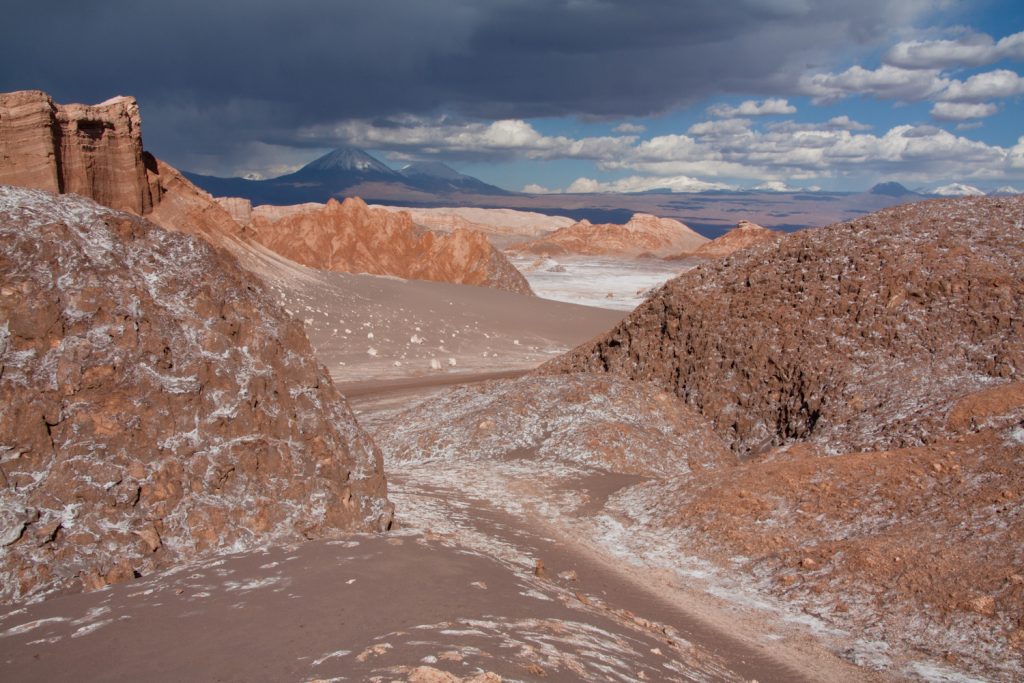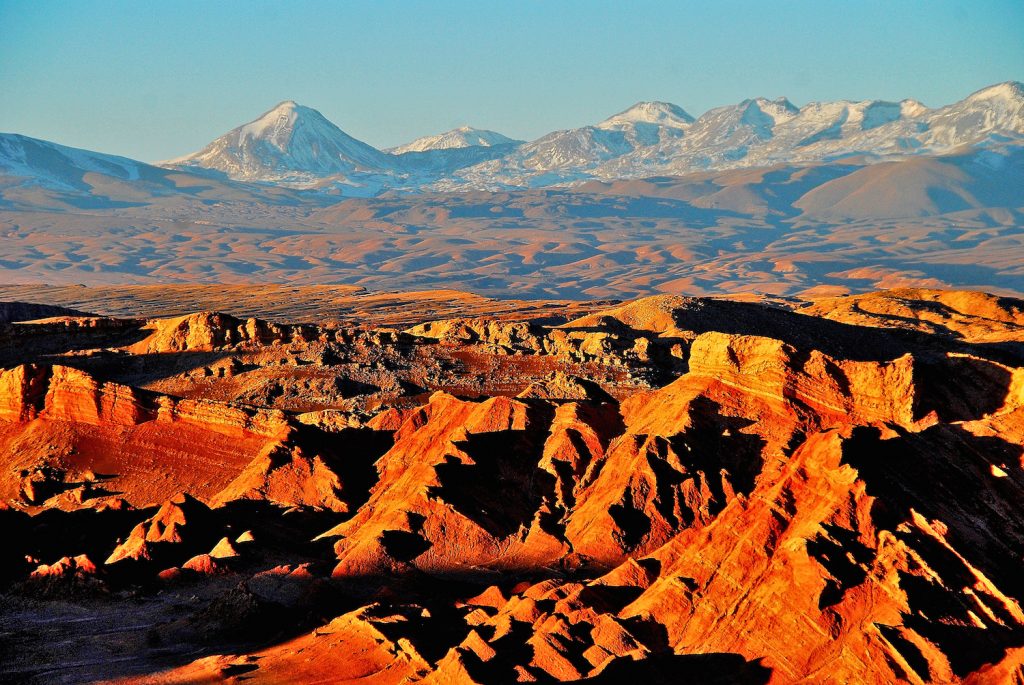The greatness of man is great in that he knows himself to be miserable (B. Pascal)
We leave at 8 in the morning from Mendoza in time for a weekend towards Valle de la Luna.
A journey of 6 hours in the car that slowly left behind us the Andes and the Mendoza vineyards introducing us into the middle of the Argentine desert.
The only desert in which I had been up to now was only that of the Sahara. The classic desert, one with yellow and silky sand, dunes and camels with caravans that, slowly, head from one point to another and with the emptiness around.
The Argentine desert is completely different.
By car from the front seat I saw kilometers of uninhabited land roll by, once in a while some little village that seemed uninhabited in which, sporadically houses can be seen, the Argentine ranches that are structures constructed with bricks made of mud and dung, and that for ceilings have the enramads or rather canes or branches.
Fragile and unstable houses that introduce me to rural Argentina, poor and of the gauchos.
When the desert takes over, in the visual it looks as if the mountains disappear, the desert depression does not have a limit, it seems endless. There are no other cars on the road, or people. The sound of the wind that insinuates between the dry bushes and the branches of the carob trees is the only sound that makes me feel small and lost in space.
The road suddenly becomes particular, it is no longer flat, a series of ditches follow one after the other. We stop the car because I think I'm in one of the most peculiar roads in the world, dozens of asphalted ditches one after the other make the moment dream-like and suggestive.
The cacti that grow on the arid land as we penetrate inside the desert increase, and so the desolation and impressiveness of a boundless space in the middle of Argentinean nothing.
After kilometers of nothing we come to the small Valle Fertil.
There is a pond that in its center has a small green and lush island, a strange contrast with the nature that surrounds it which, instead, is dry and colored in patches.
The pond has no fish anymore, the waiter of the hotel where we are and that has a view on this, tells us.
The mines that are exploded in the quarries for the search of gold has released poisonous gasses that in one night had killed all the fauna.
The only oasis of life in a desert territory that seems to die with the surrounding ground.
The days disposed to the two parks are only two so we head immediately towards Ischigualasto Park, a UNESCO World Heritage site in 2000, where the famous Argentina Valle de la Luna (not to be confused with that of Chile) is, one of the two cultural heritage of humanity parks. The Talampaya Park, I would have visited the following day.
Another 100 kilometers to reach the park, as if those done until then had not been sufficient.

And this is where the journey becomes an adventure in the park of dinosaurs, an immersion in geology and a temporal leap of millions of years in an area that stretches for 63,000 hectares.
Life on earth, in unicellular form, appeared 3,500 million years ago, but our planet is older of about 1500 million years.
Only (so to speak) 600 million years ago, have appeared multicellular organisms, then animals with the skeleton that initially lived in the water and only later on did they adapt to life on earth.
350 million years ago the first vertebrates made their appearance.
In the Ischigualasto park, one makes a journey into the Triassic period of the Mesozoic era, the era of the early dinosaurs, not by chance the remains of the oldest dinosaur in the world were found here.
The geographical boundaries of the park are natural or rather they are bordered by the sierra of Valle Fertil, the Cerro Loma Ancha, the Quebrada de los Jachalleros, the turkey oak Caballo Anca and the province of La Rioja.
I'm in the middle of the desert, where it can be very cold or very hot, where plants have changed their leaves in thorns to reduce evaporation because of the strong sunrays and where it seems there is no life.
The nature here explains how to evolve and change to adapt to climatic and geological changes, in which it is personified and introduces me to the principle of a history began millions of years ago.
Inside the park nothing gets touched nor by geologists nor by archaeologists, the nature is left alone to take its course just as the wind is left with the task of discovering fossils that help to complete the complex puzzle of our history from the dawn.

Although the park is 65,000 hectares (more than 700 square km), the tourist circuit is delimited and it is absolutely forbidden to go outside the track. The area that can be roamed is 40 kilometers .
Moving in columns in the car we follow in Indian row the procession that leads us to the discovery of the 5 major stops of the spectacular Valle de la Luna: El Gusano, Valle Pintado, Cancha de Bochas, El Submarino and the Hongo.
In this first station you can see Los Rastros, which is the oldest part of the circuit represented by rocks of 200 million years. The studies were conducted on the different sedimentations that allowed scientists to obtain information on the environment of the Triassic period. The discovery of fossils has led to state that 200 million years ago the climate was tropical, with frequent rainfall and rivers, lots of vegetation and it seems that the existence of small amphibians has been demonstrated.
The top part of the rock formation arisen from the sedimentation of sandstone deposited with the climatic changes and modeled from erosion by the wind and fractured due to the differences in temperature has generated a form that with a little bit of imagination recalls a worm, hence the name El Gusano.
A short distance from Los Rastros you arrive at the second station of the circuit called Pintado Valley. The geological formation is called Ischigualasto.
In ancient times this valley reminiscent of the lunar surface was actually an important river, a real paradise for flora and fauna. The numerous fossils found here are due to the fact that when there a serious flood happened, the animals were trapped in the waters.
The colors alternate between green, gray, brown and purple. There is no vegetation because the wall, rich in minerals is waterproof so that the growth of plants is practically impossible. If you have ever had the dream of going to the moon then this is the place to experience it.
Here nature has created something incredible. The combination of several factors, such as pressure, temperature, humidity etc., has meant that a main core formed by a mineral begins to receive the sedimentation of other minerals.
Slowly this first nucleus gets bigger becoming a compact and homogeneous element. Calcium carbonate becomes the glue of these rocks that are of perfect balls and that were created 200 million years ago.
Today with the erosions we are witnessing the coming to light of these mineral rocks from the impeccable shape, and which can be found exclusively in this particular area of the park and not in others.
On the way to the field you can see a rock which looks like the sphinx.
From here you can enjoy a splendid view of the entire park, being the highest stop of the tour.
From here you can see the results of the wind erosions on the rocks that, in thousands of years have been worn down at the base that thin as it is, keep upright a large rock in equilibrium.
This is the last leg of the tour and just like the previous stage, here you can see up close what the wind has succeeded to carve out, especially at the top, creating a shape that resembles a mushroom.
From here you can admire the splendid panorama of the Barrancas Coloradas, wall of 200 meters, that dominates the whole valley and which is the newest part of the park, that of the dinosaurs.
The red color contrasts strongly with the colors of the valley. The young Barrancas have 200,000 years ... .in 40 km I made a journey through time going back to 250 million years ago, I also made a trip to the moon but above all I got ways to see life even in those elements that I thought were without: the rocks.
After 4 hours of guided tour in the desert and for this impressive historical/geological park, the visit ended with a few minutes to the Dinosaur Museum where the remains of the oldest dinosaur in the world are found, which, in spite of what might be believed, was 1.45m tall and 2m long.
A small father of those who had become monsters whose extinction seems to remain a mystery still.
Remains and information on the Triassic period can be found in many places in the world, in many cases, however, it comes to deep sediments. In the Valle de la Luna the history of 200 million years is on the surface due to a geological and physical event occurred 70 million years ago when there was a collusion of plaques.
The Plaque of Nazca along the whole Pacific colliding with the continental plaque with such a pressure as to cause the raising of the Andes. This same pressure had effected up to the internal of the same Argentina lowering some plaques but raising others.
This phenomenon has led not only to leave a unique scenario, but it has contributed to the discovery of fossils so as to make it possible to find enough material to be able to hypothesize and reconstruct the life of previous millennia.
Ischigualasco is the only place in the world where you can see with the naked eye the historical sequence of sedimentation since the era before dinosaurs roamed the earth.
I advise to arrive at the park with your own transport rather than with a tour that could be quite expensive. Rent a car in Valle Fertil and drive through the desert. At the information center of the place you can ask for information about any tour and a map to get to the park. Admission to the park costs $ AR35 ($ 7) for non-residents. The guide is included in the ticket cost, tours depart every hour. For more information you can refer to the official website: www.ischigualasto.org
Disclaimer: In questo post, alcuni dei link forniti sono link di affiliazione, il che significa che posso guadagnare una commissione se si effettua un acquisto attraverso questi collegamenti. Tuttavia, ciò non comporta nessun costo aggiuntivo per te. Le commissioni che ricevo attraverso questi link di affiliazione aiutano a finanziare e supportare il mio blog, mantenendo così la sua indipendenza e la mancanza di sponsorizzazioni. Mi sforzo sempre di fornirti le migliori informazioni e consigli possibili, basati sulla mia esperienza e ricerca personale. Mi preme sottolineare che il tuo sostegno è fondamentale per mantenere vivo questo blog e continuare a fornirti contenuti di qualità. Grazie per il tuo supporto!
Se vuoi organizzare un viaggio su misura in Argentina organizzato da operatori locali contattami.
Anni di esperienza, prezzi competitivi, sicurezza in viaggio e turismo responsabile è quanto promettiamo!
Alcune immagini pubblicate sono state tratte da Internet, nel caso in cui, il loro utilizzo, violasse diritti d’autore, mandateci una mail a [email protected] e verranno immediatamente rimosse.